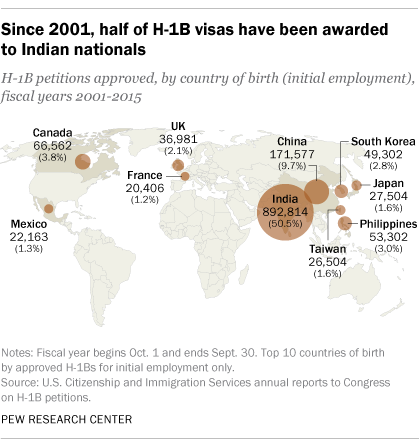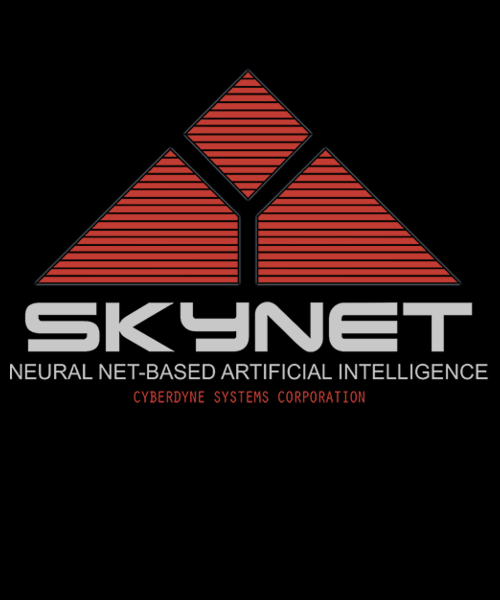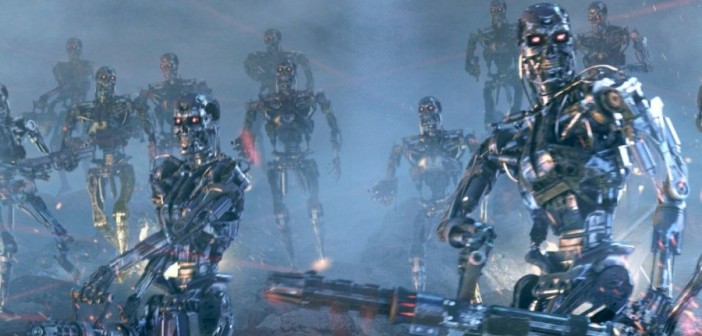IronLionZion
IronLionZion's JournalKey facts about the U.S. H-1B visa program (PEW Research)
President Donald Trump has ordered a comprehensive review of the H-1B visa program, the primary way that companies in the United States hire high-skilled foreign workers. The multiagency review is expected to result in suggested changes to ensure that the most skilled and highest-paid applicants receive H-1B visas. Though the order may be the first step in an overhaul of the program, only a handful of changes have been made for now to the way H-1B visas are awarded.
Almost 1.8 million H-1B visas have been distributed in fiscal years 2001 through 2015, according to a Pew Research Center analysis of government data. The program, created by the Immigration Act of 1990, allows employers to hire foreigners to work on a temporary basis in jobs that require highly specialized knowledge and a bachelor’s degree or higher.
Visas are awarded to employers on a first-come, first-served basis, with applications accepted each year beginning in April. If the number of applications exceeds an annual cap set by Congress during the first five business days of April, visas are awarded through a lottery system.
Here are some key facts about the current H-1B visa program.

Since 2005, H-1B visas have been capped at 65,000 a year, plus an additional 20,000 visas for foreigners with a graduate degree from a U.S. academic institution. Congress sets the annual cap, which has varied from a low of 65,000 (first set in fiscal 1990) to a high of 195,000 in 2002 and 2003. Currently, employers submit applications and pay between $1,710 and $6,460 in fees for each visa, depending on the employer’s size – a portion of which funds the National Science Foundation and the retraining of American workers through the Department of Labor’s Employment and Training Administration.


http://www.pewresearch.org/fact-tank/2017/04/27/key-facts-about-the-u-s-h-1b-visa-program/
Fun fact, the 2010 US Census showed close to 4 million Americans of South Asian heritage: Indian, Pakistani, Bangaldeshi, Sri Lankan. The 2020 census will show a much higher number. The PEW link shows 85,000 H1b visas issued each year, half of which go to citizens of India. If you know someone who thinks they tell who is a US citizen vs who is a on a visa just by looking at them or by their name, that person may often find themselves insisting they are not racist. (They protest too much)
Another fun fact, the 2010 US Census had non-hispanic whites as 63% of our population and decreasing. Americans are not white. South Asians are not on visas.
Promoting the myth that brown people are perpetual foreigners makes someone sound no better than a deplorable Trump supporter. It's the single biggest problem I face in my career.
If you want to reform the H1b and other work visa programs, lobby Congress to lower the caps on new visas issued and shorten the duration of their stay, and of course do something at the company/employer level to make them want to hire US Citizens again. Also try applying for jobs at large IT Services contracting firms. There are many American companies who do this too: IBM, Accenture, DXC, Cognizant, Deloitte. But to get the full experience you should also apply to foreign companies like Infosys, TCS, Wipro, Mahindra, etc. See for yourself the h1b life.
There must be some reason why any company in the US would go through hoops and pay for visas for a foreign worker instead of an American worker. Find out that reason through working alongside h1bs doing the same job and see for yourself.
I share your desire for reform and level the playing field for American workers. But if you could stop encouraging racism against Americans of South Asian heritage, or claiming that we are "less American" or have "less loyalty to America", that would be great.
Slowdown in Software Central: Indian-Americans in Silicon Valley (Automation)
As President Donald Trump signals ‘America First’, Indian-Americans in the Silicon Valley begin to look beyond the bubble. More than H-1B visas, it is automation that threatens to alter the dynamics for all times to come
From his hilltop perch on the eastern side, across the San Fransisco Bay, Vinod Dham has a bird’s-eye view of the Silicon Valley. When the lights come on, the headquarters of Google, Facebook, Apple, Uber and Intel — where he once led the invention that revolutionised computing, the Pentium chip — are clearly visible.
The story of Dham’s journey, from chasing DTC buses in Delhi in the 1960s as an engineering student to the Fremont mansion where he lives now, is relegated to the background as software rock stars dominate the world’s digital imagination. But the mansion is testimony to his status in Silicon Valley — the higher up the hills that surround the Valley your house is, the higher up you are in the pecking order of its cut-throat social hierarchy. An eight-tonne stone Buddha sculpted in Mamallapuram near Chennai sits in the garden.
“It is exciting, and disconcerting,” Dham says of the emerging era of computing. “Disconcerting, because of the massive job losses and social displacement that is just round the corner. Artificial Intelligence (AI) is not like anything that humanity has seen so far.”
The spectre of automation
The argument that AI will be just another in the series of technology revolutions — like machine looms, automobiles and computers — that have transformed the world to what it is today, he says, is invalid. “All machines that came before were static. They did not do anything by themselves. They only did what the humans manipulated them to do. When a machine begins to do things by itself, after it is taught how to learn, we are in a different age. I am not saying that the machines will take over and we all will be killed. But we are entering a different era.”
The immediate disruption will be human jobs, which will have a cascading effect on other aspects of society and economy, he says. And it is not only the low-end jobs that will be displaced; the existing middle class will lose their jobs as well. One could argue that new jobs in data science, algorithms, etc. will create new jobs. “But that will only be a tiny fraction of jobs that will become redundant.”
The current debates on outsourcing, offshoring, trade deficit, etc. are, therefore, already redundant, according to Dham. Each country wants to make its economy strong and create jobs. “But nobody seems to be talking about the elephant in the room.” Which is technology taking away jobs.
http://www.thehindu.com/news/international/slowdown-in-software-central/article19189515.ece
Automation is stealing jobs away from humans. A lot of testing/QA work has been automated increasingly over the years with many of the immigrants and H1Bs being laid off, and more layoffs in the offshore centers overseas too. Maybe some of the racists might back off, but I won't hold my breath.
How many DUers are pursuing careers in automation or AI or robotics? After many years of always being the token US citizen in offices of hundreds of international workers, the next step is to be the token human being to manage the machines.


Profile Information
Gender: MaleHometown: Southwestern PA
Home country: USA
Current location: Washington, DC
Member since: Mon Nov 10, 2003, 07:36 PM
Number of posts: 45,554